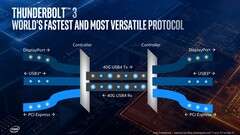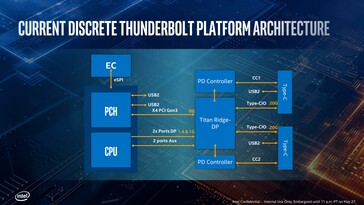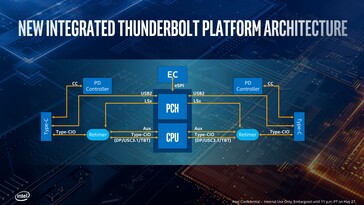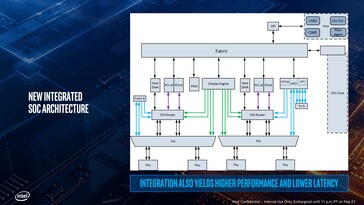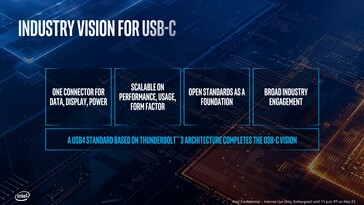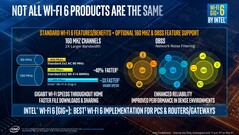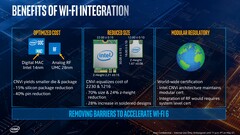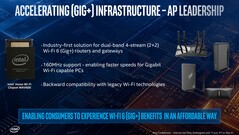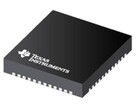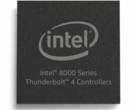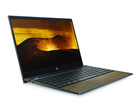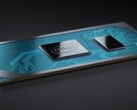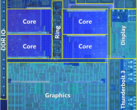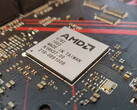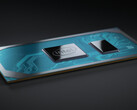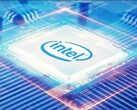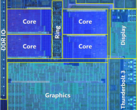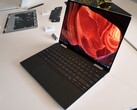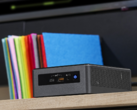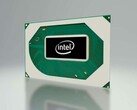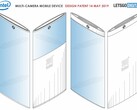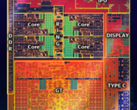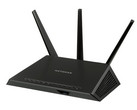The 9th gen Intel Whiskey Lake and Coffee Lake-H processors offered integrated Gigabit Wi-Fi on the PCH. What this basically means is that the non-CRF modules are integrated into the PCH while the radio components are present on a separate WLAN CRF module and both are connected via the CNVio interface. Thunderbolt 3, however, remained a discrete component wherein the Titan Ridge controller interfaced with both the PCH and the CPU. With the 10th gen Ice Lake CPUs Intel is taking a new approach to Thunderbolt 3 and Wi-Fi. Now, Thunderbolt 3 is directly integrated into the CPU and the integrated wireless on the PCH has received an upgrade to Wi-Fi 6 Gig+.
Integrated Thunderbolt 3 and upcoming USB 4
Till date, the Titan Ridge controller interfaced separately with the PCH and CPU. While the CPU got the DisplayPorts and Aux, USB2 and PCI Gen3 x4 went to the PCH. In Ice Lake, the Type-C port can directly interface with the Thunderbolt 3 controller on the CPU itself via a retimer for DisplayPort and USB 3.1 while directly connecting to the PCH for USB 2. This removes the step wherein the Type-C port has to first talk to the Titan Ridge controller in a traditional Thunderbolt 3 setup. Intel says this results in higher performance and reduced latency. It remains to be seen how much of a real-world benefit can be obtained from this integration.
With Intel making Thunderbolt 3 royalty-free and now with the integration of the controller onto the CPU itself, OEMs need not worry about sourcing the required controllers or worry about providing a two-lane or four-lane configuration. This should also help in better utilization of the real-estate on the mainboard for other components.
Intel is pushing for Thunderbolt 3 to become the next USB standard based on the USB Type-C port. USB 4 will, therefore, provide all the advantages of Thunderbolt 3 natively and will be based on open standards. Thus, a single Type-C connector can help with data, display, and power. Intel said it is working with industry partners to collectively take forward the USB 4 on USB Type-C vision.
Integrated Wi-Fi 6 Gig+
802.11ax Wi-Fi 6 Gig+ is the next evolution of the ubiquitous 802.11ac standard promising 40% higher speeds and 4x higher throughput in congested environments. Compared to a conventional Wi-Fi 6 setup, Intel's Wi-Fi 6 Gig+ offers a 160 MHz channel that can accommodate 840 Mbps in standard 2x2 Wi-Fi 6 and 1,680 Mbps in Wi-Fi 6 Gig+. Intel's implementation also features Overlapping Basic Service Sets (OBSS) noise filtering for improved reliability in crowded environments.
Intel also spoke about how integrating the non-CRF modules within the PCH can significantly reduce the size and number of pins of the CRF component helping OEMs design thinner notebooks. The company also said that it is looking to forward provide Wi-Fi 6 Gig+ chipsets such as the WAV600 for affordable dual-band home routers and gateways. These chipsets support the 160 MHz channel and are backward compatible with legacy Wi-Fi technologies.
Source(s)
Intel Press Release




